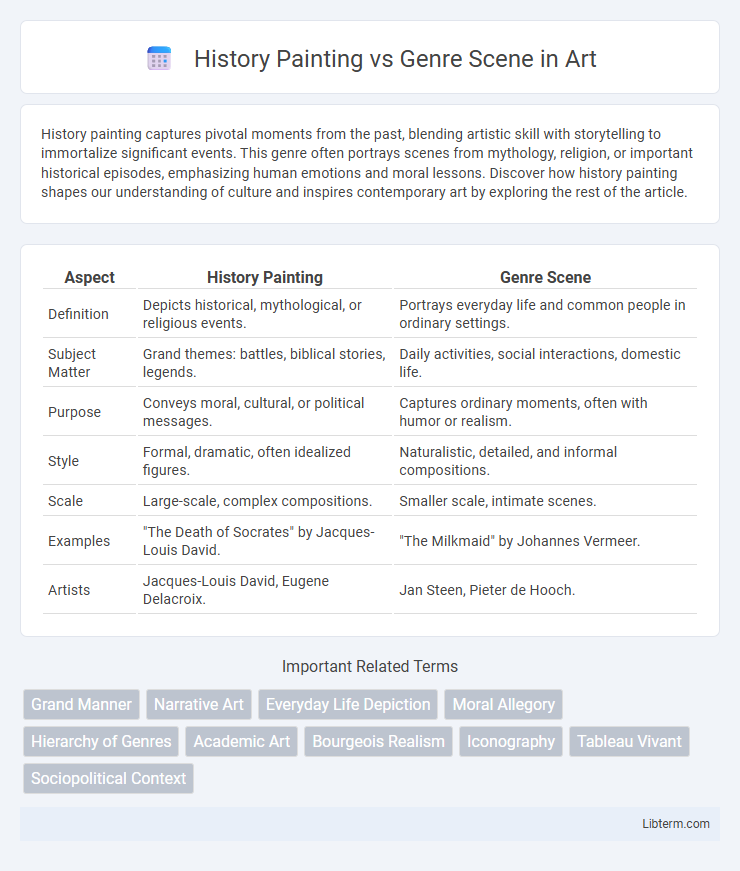History painting captures pivotal moments from the past, blending artistic skill with storytelling to immortalize significant events. This genre often portrays scenes from mythology, religion, or important historical episodes, emphasizing human emotions and moral lessons. Discover how history painting shapes our understanding of culture and inspires contemporary art by exploring the rest of the article.
Table of Comparison
| Aspect | History Painting | Genre Scene |
|---|---|---|
| Definition | Depicts historical, mythological, or religious events. | Portrays everyday life and common people in ordinary settings. |
| Subject Matter | Grand themes: battles, biblical stories, legends. | Daily activities, social interactions, domestic life. |
| Purpose | Conveys moral, cultural, or political messages. | Captures ordinary moments, often with humor or realism. |
| Style | Formal, dramatic, often idealized figures. | Naturalistic, detailed, and informal compositions. |
| Scale | Large-scale, complex compositions. | Smaller scale, intimate scenes. |
| Examples | "The Death of Socrates" by Jacques-Louis David. | "The Milkmaid" by Johannes Vermeer. |
| Artists | Jacques-Louis David, Eugene Delacroix. | Jan Steen, Pieter de Hooch. |
Introduction to History Painting and Genre Scene
History painting centers on grand narratives drawn from mythology, religion, or historical events, portraying heroic figures and moral lessons with dramatic composition and scale. Genre scenes depict everyday life and ordinary people engaging in common activities, emphasizing realism and intimate, relatable moments. Both genres reflect cultural values but differ in subject matter, purpose, and artistic approach.
Defining History Painting: Themes and Characteristics
History painting centers on grand narratives from mythology, religion, and historical events, emphasizing heroic figures and moral lessons. It often features dramatic compositions, idealized forms, and a formal approach to storytelling that conveys universal truths. This genre prioritizes elevated subject matter and emotional intensity, distinguishing it from everyday scenes depicted in genre painting.
Understanding Genre Scene: Everyday Life in Art
Genre scenes capture everyday life moments, portraying ordinary people engaged in common activities such as cooking, market visits, or family interactions. Unlike history paintings, which depict grand narratives, religious events, or mythological subjects with heroic figures, genre scenes emphasize the detailed, realistic representation of daily existence and social customs. This focus highlights cultural values and offers insight into the socio-economic conditions of the time, making genre scenes essential for understanding historical contexts through art.
Historical Development of History Painting
History painting, emerging during the Renaissance, became the pinnacle of artistic achievement due to its emphasis on grand narratives from mythology, religion, and classical history. This genre evolved with artists like Poussin and Rubens, who infused dramatic compositions and moral lessons, elevating it above other art forms in academic hierarchies. By the 19th century, the rise of genre scenes, depicting everyday life, challenged history painting's dominance, yet history painting remained influential for its role in educating and inspiring through monumental storytelling.
Evolution of Genre Scenes in Art History
Genre scenes evolved significantly during the Dutch Golden Age, shifting focus from grand historical or biblical narratives to everyday life and ordinary people, reflecting social and cultural changes in 17th-century Europe. Unlike history painting, which portrayed heroic or mythological subjects with moral or didactic purposes, genre scenes emphasized realism, intimacy, and the mundane, contributing to a democratization of art themes. This evolution continued into the 19th and 20th centuries, influencing movements such as Realism and Impressionism, which celebrated contemporary life and common experiences over traditional historical grandeur.
Key Differences Between History Painting and Genre Scene
History painting depicts grand, often historical or mythological events with heroic figures, emphasizing moral or intellectual themes. Genre scenes portray everyday life and ordinary people, highlighting mundane, relatable activities without grand narrative or allegorical content. The key difference lies in their subject matter's scale and significance: history paintings aim for cultural or educational impact, while genre scenes capture daily human experience.
Influential Artists in History Painting
History painting, a dominant genre from the Renaissance through the 19th century, features influential artists like Jacques-Louis David, whose work "The Death of Marat" exemplifies neoclassical ideals and revolutionary themes. Peter Paul Rubens contributed dynamic compositions and dramatic narratives to history painting, while Eugene Delacroix introduced Romantic vibrancy and emotional intensity in works such as "Liberty Leading the People." These artists shaped history painting as a prestigious genre that emphasized grand historical, religious, and mythological subjects, contrasting with the everyday life scenes depicted in genre painting.
Prominent Masters of Genre Scene
Prominent masters of genre scene painting, such as Jan Steen, Pieter Bruegel the Elder, and Jean-Baptiste-Simeon Chardin, captured everyday life with vivid detail and social commentary, distinguishing their work from the grand historical narratives of history painting. These artists emphasized ordinary people, domestic interiors, and common activities, reflecting cultural and social realities rather than mythological or religious themes. Their contributions helped elevate genre scenes to a respected art form by showcasing nuanced human experiences and daily routines.
Cultural and Social Impact of Both Genres
History painting often depicts significant historical, religious, or mythological events, reinforcing cultural values and collective memory while shaping national identity and moral ideals through grand narratives. Genre scenes portray everyday life, capturing social customs and behaviors that offer intimate insights into the lived experiences of different classes, thus influencing public perception and preserving cultural traditions across generations. Both genres contribute uniquely to cultural discourse: history paintings assert authoritative cultural narratives, while genre scenes democratize art by reflecting ordinary social realities.
Contemporary Relevance of History Painting and Genre Scene
History painting, traditionally revered for depicting grand narratives and moral lessons, maintains contemporary relevance by addressing current social and political themes through symbolic and allegorical imagery. Genre scenes, portraying everyday life and ordinary people, resonate today by reflecting diverse cultural experiences and highlighting social realities, thus fostering empathy and dialogue. Both art forms continue to influence modern visual storytelling, blending historical context with present-day issues to engage contemporary audiences.
History Painting Infographic

 libterm.com
libterm.com